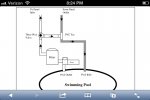Howdy - any advice would be appreciated as I can't find the particular answers within the site (which ROCKS).
Background: I will be re-installing a 12' round Intex metal frame AGP (for the 2nd season) and integrating a new pump, solar panel and blanket (specs below). My goal is to raise/maintain the temperature while maximizing potential and preserving my investment.
I have further leveled my pad and anticipate better setting compared to previous years, as there is a slight pitch in the lawn (approx. 3" per 12'). I will have 35% of pool surface represented with one panel, may add another next year if configuration/budget allows. Space dictates I place the panel on ground level adjacent to the pool (I may configure a rack to angle it). The panel header would be about 6' away from the pool and the tubes would run 'downhill'. Questions:
1. Given that the panel is below the water level and ever-so-slightly 'downhill' (even if there's a rack involved), am I better off with a 3-way valve vs. a diverter (bypass) valve? It seems to me that with a diverter open (solar off), gravity will push some H2O through it. Or do I not get the hydrodynamics and despite the 'downhill' placement, I need to close the diverter to force the panel to engage? I don't anticipate ever closing a diverter all the way as I've gone a bit overkill on the pump flow vs. pool size and I don't want to over-pressurize the panel (it's an Ebay special).
2. Do I need a vacuum break? I'm thinking no, as it's not above water level.
Thanks,
Background: I will be re-installing a 12' round Intex metal frame AGP (for the 2nd season) and integrating a new pump, solar panel and blanket (specs below). My goal is to raise/maintain the temperature while maximizing potential and preserving my investment.
I have further leveled my pad and anticipate better setting compared to previous years, as there is a slight pitch in the lawn (approx. 3" per 12'). I will have 35% of pool surface represented with one panel, may add another next year if configuration/budget allows. Space dictates I place the panel on ground level adjacent to the pool (I may configure a rack to angle it). The panel header would be about 6' away from the pool and the tubes would run 'downhill'. Questions:
1. Given that the panel is below the water level and ever-so-slightly 'downhill' (even if there's a rack involved), am I better off with a 3-way valve vs. a diverter (bypass) valve? It seems to me that with a diverter open (solar off), gravity will push some H2O through it. Or do I not get the hydrodynamics and despite the 'downhill' placement, I need to close the diverter to force the panel to engage? I don't anticipate ever closing a diverter all the way as I've gone a bit overkill on the pump flow vs. pool size and I don't want to over-pressurize the panel (it's an Ebay special).
2. Do I need a vacuum break? I'm thinking no, as it's not above water level.
Thanks,



